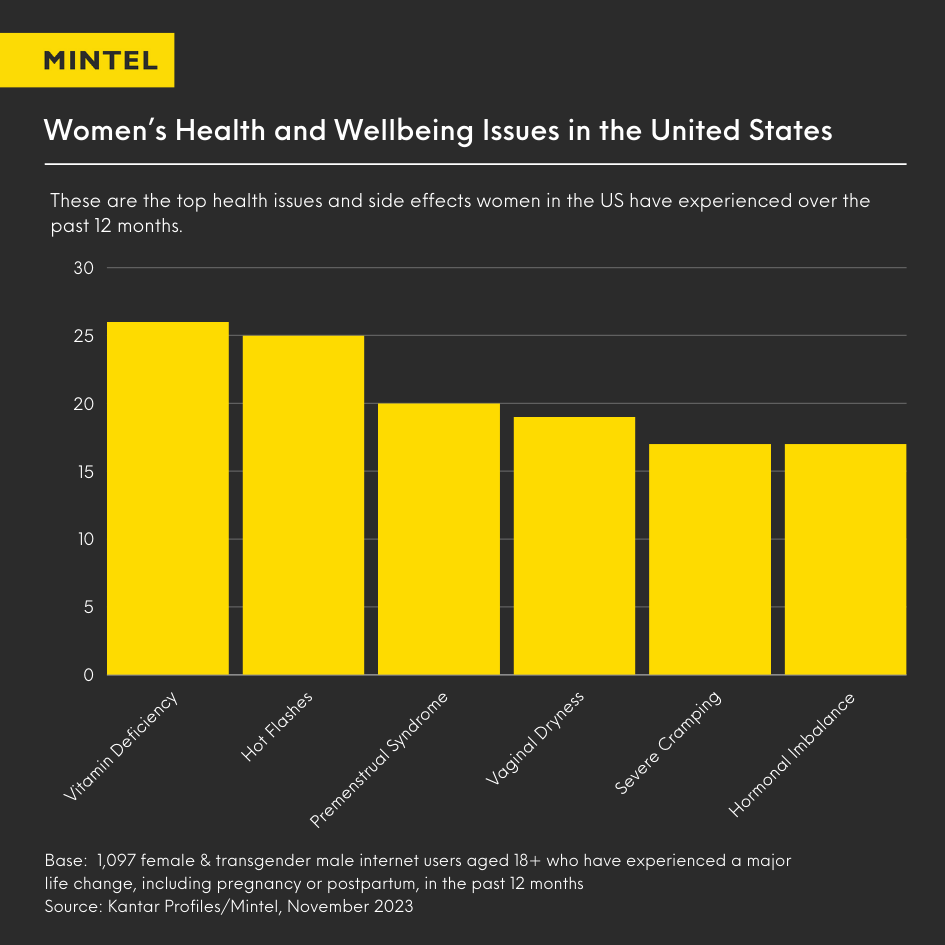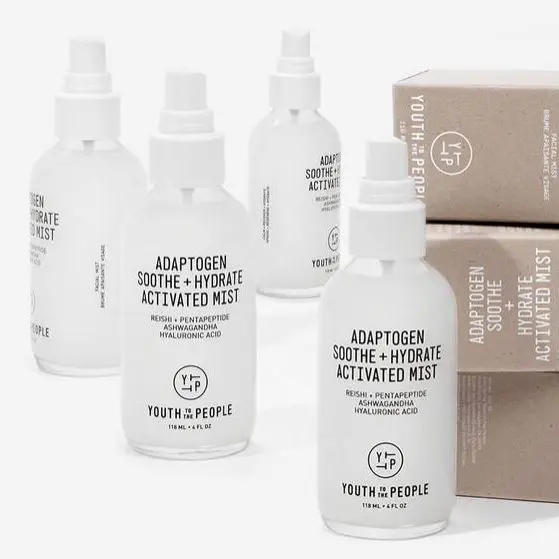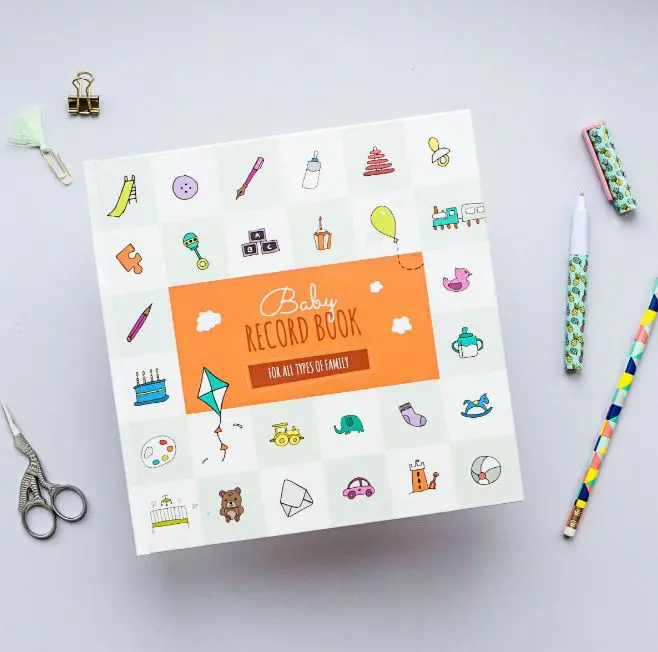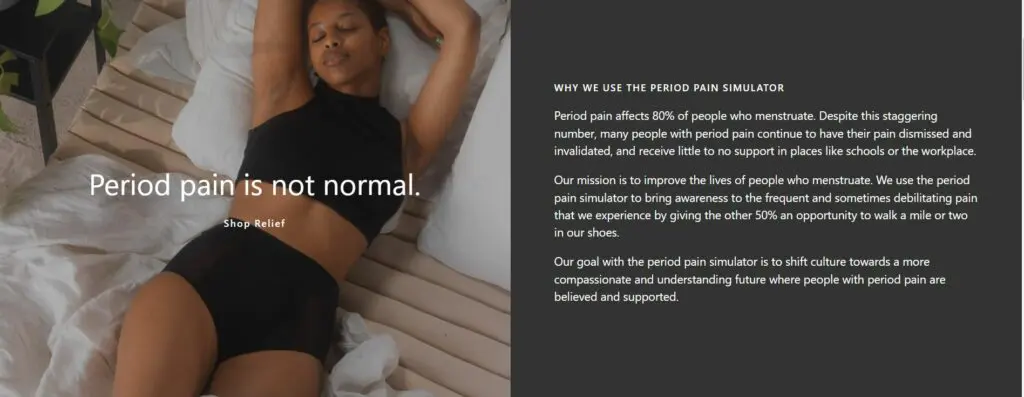During the pandemic women have been stretched especially thin, saddled with the responsibility of caring for family and work obligations, while also looking out for their own personal wellness. Now, they are becoming more familiar and comfortable with understanding and managing their symptoms. This is due to more education and less social stigmatization around women’s health and wellbeing issues.
Read on to find out what’s driving women’s wellness trends in 2024 in the US; from demands calling for more diversity and convenience to education and information campaigns in an effort to further destigmatize women’s health conditions across different life stages.
With Mintel’s insights, you can learn what areas your business should focus on and what you can do to support women of different ages and backgrounds in fulfilling their health and wellbeing needs.
US American Women’s Wellbeing Issues Today

Vitamin deficiency is the most commonly faced issue by women. Although younger women aged 18 to 44 are slightly more likely to experience vitamin deficiency, it is still an issue that affects women throughout their lives. Mintel’s women’s health trends research found that consumers consider vitamins to be safe and effective ingredients with well-known benefits. Brands can help make vitamins easier and more enjoyable to consume through solution-oriented aspects within their product, such as dairy’s impact on bone health, tea’s ability to help manage symptoms, or implementing vitamins into body care products.
Mental health issues are also more commonly experienced by younger women. The top sources of stress are their financial situation, worries about the future, and personal relationships. While those aren’t exclusive to the younger generation, they are more likely to find themselves in a financially insecure situation and a future that is yet to be explored. Products with mood-boosting effects that improve women’s wellbeing overall can benefit them and help reduce the stress of day-to-day life.

Youth to the People already utilizes Ashwagandha in their products, which is known for its stress-reducing effects. Source: youthtothepeople.co.uk
Proactive Wellness. As particularly Western populations are aging, women are interested in products that span life stages. Brands will have to take older generations’ needs into account; that means offering products to menopausal women and products that span longer lengths of time. Women’s health trends show that rather than having to switch to new products each time physical changes occur, women prefer articles that cater to a variety of ages and needs. As Gen X and Millennial women approach perimenopause and menopause, brands need to be prepared to create solutions that are customizable and make the transition from menstruation to menopause easier and less stressful. Mintel’s women’s wellness research found that women find it difficult to manage menopausal symptoms due to their variety and rapid onset. In addition to solution-focused symptom relief, brands need to consider making solutions fast-acting for immediate alleviation. Technology, such as wearable devices like the Oura Ring that offer temperature regulation can help women to monitor their temperature and offer them a proactive approach to dealing with symptoms before they become unbearable.

Oura helps women of all ages connect to their bodies and listen to their symptoms to understand what they need to thrive. Source: ouraring.com
Beyond One-Size-Fits-All. While there are many things that connect women all over the globe, there are unique sub-groups or individuals whose needs are more specific and demand tailored solutions. For example, Hispanic women prefer online methods that allow them to do their own research on women’s wellness and health information. They are also most likely to make purchasing decisions based on this research, which calls for a strong online presence and comprehensive product information from brands to help connect with this consumer group.
Compared to other consumer sub-groups, black women are not as comfortable discussing their period, however, there is a desire to discuss their period-related health issues more openly. This emphasizes the need for brands to consider inclusivity when working to further normalize menstruation. For example, Mintel’s women’s wellbeing and health report shows that almost 50% of black women describe their flow as heavy or very heavy, and in turn over half of black women select period products based on their ability to handle a heavy flow. Brands should consider the needs of different racial backgrounds and their unique needs to effectively market their products to be inclusive of all women’s needs.
Four Unique Ways Your Brand Can Support Women’s Health and Wellbeing
1. Help Women Destress
The majority of women continue to take on most caring and household responsibilities on top of their professional careers. By helping them find ways to destress throughout their day through self-care products that are enjoyable to consume or use, women will be better equipped to manage their stress and anxiety.
2. Acknowledge and Target Diverse Audiences
Diverse audiences include a variety of aspects from different racial groups, over LGBTQ+ consumers, to different ages. Brands that cater to their individual needs, such as the online research preferences of Hispanic women, or the demand for products by black women, will be ahead of competitors.
Many LGBTQ+ adults agree that brands have the power to improve their acceptance in society, and are demanding products that are inclusive, but without feeling gimmicky or inauthentic. Therefore, brands focusing on meeting maternal needs have opportunities to connect with LGBTQ+ parents who are more than twice as likely to be trying to conceive

UK small business Little Pickle Memories make baby books and gifts suited to the needs of all types of families, including LGBTQ+ parents. Source: littlepicklememories.com
According to Mintel’s women’s health trends insight, LGBTQ+ consumers have higher interest in reusable, organic, longer-use period products: 25% of LGBTQ+ compared to 14% of non-LGBTQ+ consumers. This makes them a prime focus for brands selling period underwear and reusable pads, and makes these products a tool for promoting inclusivity and sustainability simultaneously.
3. Support Women’s Wellness Through Convenience
Women in the US are savvy shoppers, do their own research, and multi-task. They are usually in charge of household and care work while simultaneously juggling their own day-to-day job and their health and wellness. As such, they are most in need of brands that make things easy for them, including being easy to use, easy to acquire, and easy to understand.
While convenience is a must-have, brands can differentiate themselves through second tier purchase factors, such as messaging that indicates an authentic understanding of women’s needs, natural and recognisable materials or ingredients, peer recommendations, and personalised products.
4. Invest in Expanding Education on Women’s Health and Wellbeing
There are varied comfort levels when discussing women’s health, with comfort levels generally increasing with age, and depending on who they’re talking to, with women generally being less comfortable discussing topics with men.
Because of women’s need for evolving information as their life progresses, education is a crucial element to help reduce shame and help empower women to seek relief instead of opting to deal with struggles on their own. Education will help normalize health issues which many women aren’t comfortable with being open about. Not only will an increase in information circulation reduce shame surrounding women’s health topics, but it will also empower them to feel more prepared before starting new life stages, such as menopause. As of right now, only 28% of women in the US who have experienced menopause were prepared for what lay ahead of them. This shows that there is a huge information gap that needs closing.
Women’s wellness brand Somedays, for example, hopes to shift the narrative around period pain to be more compassionate through their viral period cramp simulation videos that show people reacting to symptoms that women experience once a month. The brand educates about how period pain is not normal to destigmatize women seeking relief for their symptoms instead of struggling because they think they have to.

Somedays spread awareness of period pain and how it affects those who menstruate in their day-to-day lives with their period pain simulator videos on social media. Source: somedays.com
Millennials have increasingly developed higher trust in the information they receive through social media – nearly half of US Millennials think that YouTube is a good resource when they want to learn about something. Brands wanting to leverage social media will need to be able to combat misinformation to be able to make themselves be seen as figures of authority. To help build this credibility, brands can utilize licensed medical professionals in messaging, digestible scientific explanations, and engage their audience through Q&As or live sessions.
Normalizing conversation around women’s health and wellness won’t only support destigmatization, but increase category engagement. The majority of women don’t think that brands accurately present what periods are actually like, and are demanding more efforts to stray away from the polished period experience that is shown in advertisements.
Women’s health and wellbeing education not only covers information shared with the wider population to help them understand women’s struggles, but also includes supporting women in educating themselves about their own bodies. A quarter of 18 to 24-year-old women in the US and nearly 30% of 25 to 34-year-olds show interest in wearable technology to track their fertility or period cycles. The Oura Smart Ring mentioned above is a singular product that is successfully advertised to women in different life stages based on their current needs.
The Future of Women’s Health Trends
A growing number of women and girls, as well as brands, are working to bring attention to issues of inequality in the health and wellbeing space, and aim to help close the gaps that still exist. For marketers, this translates to huge opportunities to support these efforts. Moreover, there’s plenty of demand for products, services, and even corporate policies that help level the playing field.
Consumers are also doing their own research, meaning that brands that can keep their offerings front and center in online searches and on social platforms will have a strong chance of catching the attention of and gaining customers. Women’s wellness brands that can step in and provide clear, convenient solutions to health issues will be successful. Beyond that, emphasizing that women have to consider their own personal needs, and put themselves first in order to take better care of the needs of others will resonate.
Going forward, more women will understand their needs better and demand higher-quality health solutions that are effective and beneficial to women’s overall wellness. Be part of the force for change, using Mintel’s Wellness Market Research to guide your successful growth. You can also dive into US Women’s Wellness Consumer Report to discover how women are staying ahead of their health by looking for products that easily fit into their daily routines.
Sign up to Mintel Spotlight below to receive fresh and free market insights, delivered directly to your inbox.






























